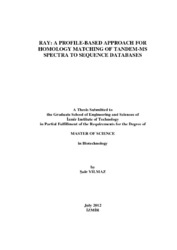Please use this identifier to cite or link to this item:
https://hdl.handle.net/11147/3501Full metadata record
| DC Field | Value | Language |
|---|---|---|
| dc.contributor.advisor | Allmer, Jens | en |
| dc.contributor.advisor | Karaçalı, Bilge | en |
| dc.contributor.author | Yılmaz, Şule | - |
| dc.date.accessioned | 2014-07-22T13:51:41Z | - |
| dc.date.available | 2014-07-22T13:51:41Z | - |
| dc.date.issued | 2012-07 | - |
| dc.identifier.uri | http://hdl.handle.net/11147/3501 | - |
| dc.description | Thesis (Master)--Izmir Institute of Technology, Biotechnology, Izmir, 2012 | en |
| dc.description | Includes bibliographical references (leaves 46-50) | en |
| dc.description | Text in English; Abstract: Turkish and English | en |
| dc.description | xii, 50 leaves | en |
| dc.description.abstract | Mass spectrometry is a tool that is commonly used in proteomics to identify and quantify proteins. Thousands of spectra can be obtained in just few hours. Computational methods enable the analysis of high-throughput studies. There are mainly two strategies: database search and de novo sequencing. Most of the researchers prefer database search as a first choice but any slight changes on protein can prevent identification. In such cases, de novo sequencing can be used. However, this approach highly depends on spectral quality and it is difficult to achieve predictions with full length sequence. Peptide sequence tags (PST) allows some flexibility on database searches. A PST is a short amino acid sequence with certain mass information but obtaining accurate PST is still arduous. In case a sequence is missing in database, homology searches can be useful. There are some homology search algorithms such as MS-BLAST, MS-Shotgun, FASTS. But, they are altered versions of existing algorithms, for example BLAST has been modified for mass spectrometric data and became MS-BLAST. Besides, they are usually coupled with de novo sequencing which still possess limitations. Therefore, there is a need for novel algorithms in order to increase the scope of homology searches. For this purpose, a novel approach that is based on sequence profiles has been implemented. A sequence profile is like a table that contains frequencies of all possible amino acids on a given MS/MS spectrum. Then, they are aligned to sequences in database. Profiles are more specific than PSTs and the requirement for precursor mass restrictions or enzyme information can be removed. | en |
| dc.language.iso | en | en_US |
| dc.publisher | Izmir Institute of Technology | en_US |
| dc.rights | info:eu-repo/semantics/openAccess | en_US |
| dc.subject.lcsh | Bioinformatics | en |
| dc.subject.lcsh | Bioinformatics--Databases | en |
| dc.subject.lcsh | Mass spectrometry | en |
| dc.subject.lcsh | Database searching | en |
| dc.subject.lcsh | Proteomics | en |
| dc.title | Ray: a Profile-Based Approach for Homology Matching of Tandem-Ms Spectra To Sequence Databases | en_US |
| dc.type | Master Thesis | en_US |
| dc.institutionauthor | Yılmaz, Şule | - |
| dc.department | Thesis (Master)--İzmir Institute of Technology, Bioengineering | en_US |
| dc.relation.publicationcategory | Tez | en_US |
| item.grantfulltext | open | - |
| item.openairetype | Master Thesis | - |
| item.openairecristype | http://purl.org/coar/resource_type/c_18cf | - |
| item.cerifentitytype | Publications | - |
| item.languageiso639-1 | en | - |
| item.fulltext | With Fulltext | - |
| Appears in Collections: | Master Degree / Yüksek Lisans Tezleri | |
Files in This Item:
| File | Description | Size | Format | |
|---|---|---|---|---|
| T001045.pdf | MasterThesis | 1.36 MB | Adobe PDF |  View/Open |
CORE Recommender
Page view(s)
208
checked on Dec 23, 2024
Download(s)
40
checked on Dec 23, 2024
Google ScholarTM
Check
Items in GCRIS Repository are protected by copyright, with all rights reserved, unless otherwise indicated.